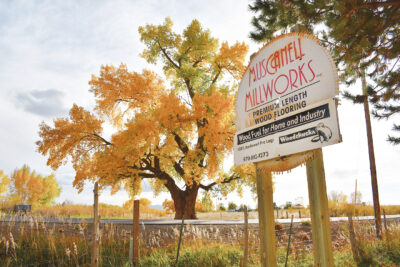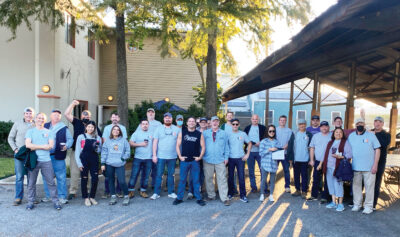
Demonstrating the legality and sustainability of the U.S. Hardwood industry has long been a major focus of AHEC’s promotional activities. From the early Life Cycle Assessment (LCA) work and the Seneca Creek Risk Assessment study to the interactive forest map and American Hardwood Environmental Profile we have been able to provide the industry with a variety of tools to tell our environmental story. Now, technology is providing us with the ability to go a step further in validation. We are currently involved in a pilot project with WorldForestID (WFID) to use science-based traceability techniques like stable isotope ratio analysis (SIRA) to georeference timber and provide irrefutable proof of origin, in some cases down to just a couple square miles.
“SIRA is already proven in agriculture, where it provides provenance for meat, wheat and other food stuffs, and has been used to an extent in the timber trade to assist companies in carrying out due diligence and ensuring compliance with EUTR and similar laws,” said AHEC European Director David Venables. “From our discussions with WFID, we believe it can be applied at large scale for provenance in the U.S. Hardwood sector, representing a potentially significant advance in environmental assurance. With FIA data we can demonstrate that the forest is sustainably managed, the Seneca Creek report provides evidence of good forest governance, while our LCA research details the environmental impacts of producing and processing and shipping the timber. Science-based traceability can underpin all this by providing categoric evidence of where the wood came from. It looks set to be another hugely valuable piece of the sustainable sourcing jigsaw.”
SIRA involves analysis of the isotopes of chemical elements in organic matter – nitrogen, hydrogen carbon, sulphur and oxygen – which are absorbed during a plant or animal’s life. Different isotopes have different numbers of neutrons and the blend is unique to the location where the plant or animal grew and lived. The system effectively provides a chemical geographic fingerprint which can’t be faked, unlike a paper-based certification system.
To date, isotope analysis has been applied to only around 125 U.S. Red and White Oak samples. The data from this is probably just enough to confirm that products in these Hardwoods are from the U.S., possibly from specific states. But by increasing sampling intensity the level of resolution can be greatly improved to give proof of origin from specific forest inventory units, watersheds, even stands.
WFID, AHEC’s partner in the pilot study, is a consortium comprising of SIRA experts Agroisolab, Kew Royal Botanic Gardens, the Forest Stewardship Council certification scheme, the U.S. Forest Service International Programs office, and the World Resources Institute.
It has already undertaken test projects in Gabon and Malaysia working with Okoumé and Meranti. With AHEC, it put forward a proposal to the U.S. Department of Agriculture via the U.S. Forest Service International Programs and secured a grant of $300,000 for the American pilot program. This will be used to start building reference datasets for a variety of technologies, including SIRA, and to support applied research to explore the finest geographic resolution that can be achieved with each method or combinations of methods.
The research is being undertaken at various forest sites in Kentucky and will run until the end of 2021. The species selected for the trial are White Oak and Tulipwood, or Yellow Poplar. Both are highly commercial timbers, with White Oak an example of a Hardwood with multiple sub-species, Tulipwood being a single homogenous species.
It’s hoped the first outcomes of the project will be known later this year, in time for the November COP 26 Climate Change talks in Glasgow.
Depending on the success of the pilot and given the will and the funding, AHEC believes science-based traceability could be rolled out across the entire U.S. Hardwood forest.
It could be seen as having still greater value in the American Hardwood industry due to the relatively low uptake of conventional chain of custody certification. There are over nine million private forest owners in the U.S., many of them family smallholders. Most, to date, seem deterred from getting certified by the technical complexity, relative cost, administrative burden, and lack of incentives for operations of their scale. Science-based traceability, however, requires a one-off test of samples from a forest region to create a permanent geo referenced record. This can then be used in conjunction with other sources of evidence, such as FIA data and the Seneca Creek assessments, that these smallholdings are sustainably managed and the timber from them legally produced.
With the data we already have, SIRA gives us a profile that we can use to definitively link actual timber production to demonstrably sustainable forests. This sort of data is clear and far less prone to the error, misuse and fraud to which some other verification systems have been vulnerable. Another benefit of SIRA is that American Hardwood products can be tied to specific forests areas where there is good quality data on forest carbon sequestration, giving an even more definitive carbon profile for those products.
WFID believes that an isotope reference library for the entire U.S. Hardwood forest could be established at an acceptable cost and relatively quickly, in as little as a few years.
The U.S. also has the potential to become an international template for large-scale, industry-wide use of science-based traceability in the forest sector. In the not-too-distant future, it could be much more difficult to trade in illegal, unsustainably sourced timber worldwide.








